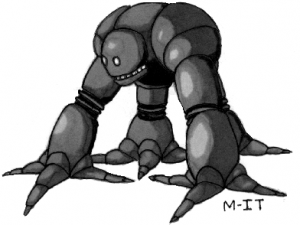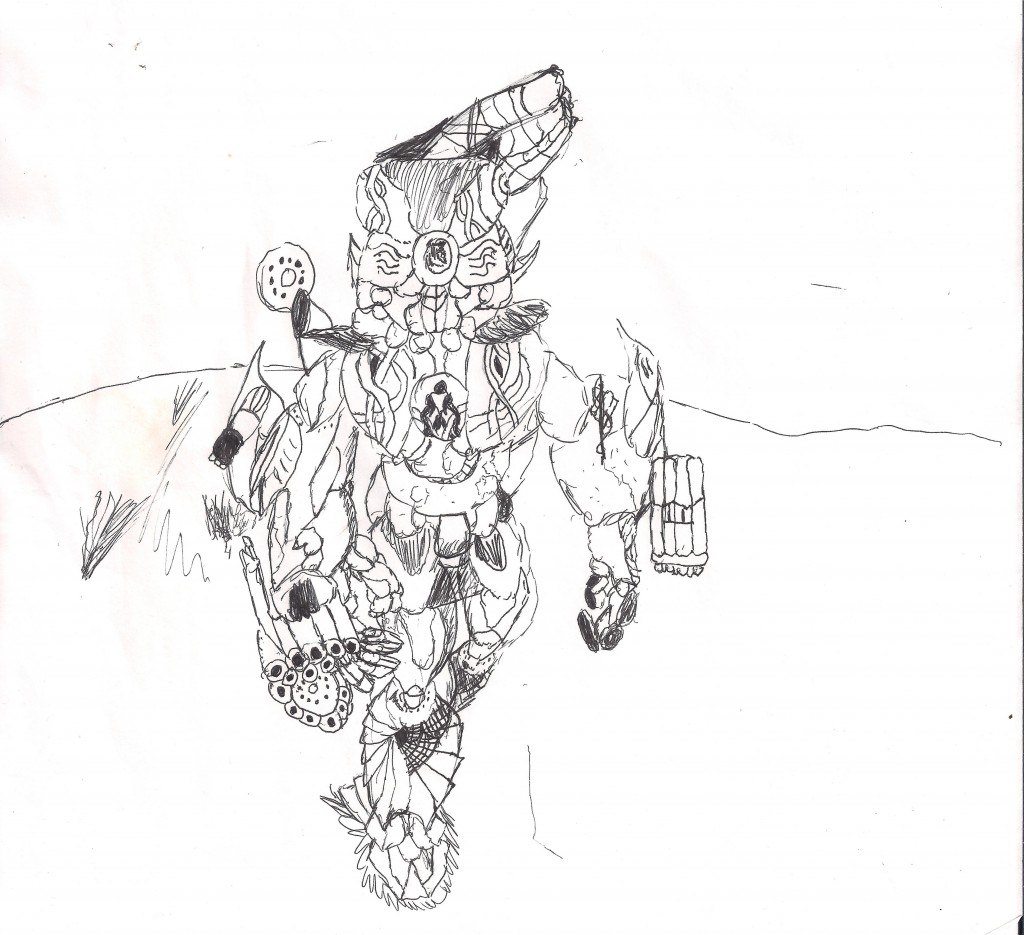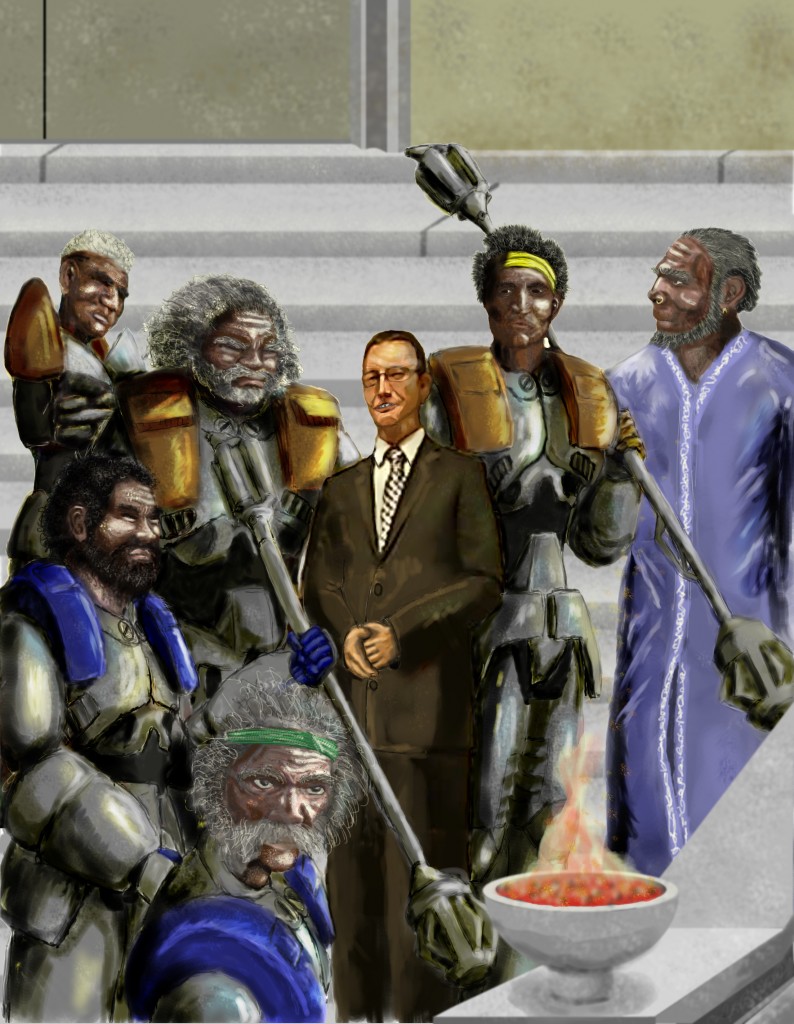When a person in Chezbah society is suspected to be guilty of a crime, select men that have been given the title “Strong Man” are responsible for catching and detaining the criminal. These are usually physically fit upstanding men in the community. They are not paid for this job but are revered for their authority. Once detained, it is primarily the role of the Priests to act as judges. This can be a problem as not all communities have resident priests, small communities have to wait months for a traveling priest. The Strong Man now presents his evidence and the Priest examines the case. Because of their access to vast knowledge, Priests are reasonably well suited to this task.
The Strong Man has to be careful, if the Priest disagrees with his findings he can be stripped of his title or even charged with the crime he accused the detained person of.
The Sentence
As one might expect, punishment for crimes, especially those against Loc are particularly harsh. They can at times result in death for an entire family. Most crimes that do not involve religious or governmental matters will involve incarceration of one form or another and prison sentences can be lengthy.
Prison also includes re-education programs that brainwash the prisoner.
There are two possible options available to a prisoner to get them out of jail time. They can opt to be Scourged or they may be offered to take combat hazard duty.
Criminal Scourges
Since the Chezbah are a strongly patriarchal society, if a family head is to be incarcerated, it usually sentences his family to poverty. In this situation a man can opt to be Scourged instead. These are not the combat Scourge in the The Artifact game book but specific criminal Scourges that turn the prisoner into an agricultural or industrial commodity.
First the prisoner is subjected to a period of re-education to obey. The scourge is usually reduced to a drone that just takes commands. He is rented to businesses and most of the money goes to the family, the rest goes to the priesthood for providing the rehabilitation. The rent is usually enough for the family to live on. The family can care for the scourge in their home if they choose, sometimes the families don’t want to be seen with the scourge and let the companies keep them in their facilities. When this happens the scourge usually suffers physically due to mistreatment.
Social acceptance of criminal scourges ranges from place to place. Sometimes they are viewed as noble for sacrificing themselves for their families. Sometimes they are viewed with disdain because they were criminals.
Pickers
The scourges hands deform and the thumb and the index finger separate from the rest of the fingers. The hand becomes very long. The arms fold upward while at rest now and the hand folds downward looking like a praying mantis. Even in this position the index fingers and thumb reach the ground. Ridges form along the extended hand and eventually can be moved in an undulating motion. The fingers also develop fine hairs that increase their sensitivity to touch and an acute sense of smell. This allows them to find fruit and vegetation for picking without actually seeing the item being picked. The ridges convey the picked item up or down the hand. A bag is carried by the remaining three fingers of the hand and picked items are conveyed into the bag.
There are some other uses for pickers like reaching high places in construction etc and the scourges can adapt to these uses.
1 Month -5 to AGI -5 DEX +10 cm reach
2 Months -10 to DEX -5 from PSY +10 cm reach
3 Months -10 to DEX +10 cm reach
4 Months +5 to AGI -5 from PSY +15 cm reach
5 Months +5 to AGI -5 from PSY +15 cm reach
6 Months +10 AGI +5 INT-5 from PSY +15 cm reach
8 Months +10 AGI +5 INT-5 from PSY +15 cm reach
1 Year +5 INT-5 from PSY +20 cm reach
Sorters
This scourge is used to sort food items or industrial parts. The pinky finger rotates and becomes another thumb. The middle finger falls off and the rest of the fingers elongate. the hand separates into two individual hands. The brain starts to process information from each eye individually and the eyes are now independent of each other so that they can be pointed in different directions. The pupils become larger to increase the peripheral vision. The brain also handles actions in three separate zones. One for each hand and one for the legs.
1 Month -5 to AGI -5 DEX
2 Months -5 to DEX -5 from PSY
3 Months -10 to DEX +5 REF
4 Months +5 to REF -5 from PSY +5 cm reach
5 Months +5 to REF -5 from PSY +5 cm reach
6 Months +10 REF +5 INT-5 from PSY
8 Months +15 REF +5 INT-5 from PSY
1 Year +15 REF +5 INT-5 from PSY
Brutes
This scourge is similar to the Wall in that it increases strength but the brute lacks the armor and regeneration abilities of the Wall scourge. Brutes are actually much stronger than the Wall but have less of a negative agility and dexterity modifier.
1 Month +10 STR +10 CON -5 DEX
2 Months +15 STR +10 CON -5 to DEX -5 from PSY
3 Months +15 STR +10 CON
4 Months +15 STR +5 CON -5 from PSY
5 Months +15 STR +5 CON -5 from PSY
6 Months +15 STR +5 CON -5 from PSY
8 Months +20 STR +5 CON -5 from PSY
1 Year +20 STR +5 CON -5 from PSY
Counters
These scourge are not altered physically. However their brains are rewired to handle numbers in huge quantities. The scourge can easily handle monetary transactions and do numerical analysis of data. They also rarely forget numerical data.
1 Month +5 IQ
2 Months +5 IQ +10 Mathematics Skill -5 from PSY
3 Months +5 IQ +10 Mathematics Skill
4 Months +5 IQ +10 Mathematics Skill -5 from PSY
5 Months +5 IQ +10 Mathematics Skill -5 from PSY
6 Months +5 IQ +20 Mathematics Skill -5 from PSY
8 Months +5 IQ +5 INT +20 Mathematics Skill -5 from PSY
1 Year +5 IQ +5 REF +25 Mathematics Skill -5 from PSY
Combat Hazard Duty
With the readily disposable Chezbah Hound available, a criminal taking hazard duty is more likely to get a tedious assignment that requires some human intelligence. This can mean sitting in outposts for months on end at a Kelrath contested region with only fellow criminals as companions and Hounds as jailers. The Hounds will prevent the criminals from leaving their posts, especially when attacked.






 The Free RPG Blog
The Free RPG Blog